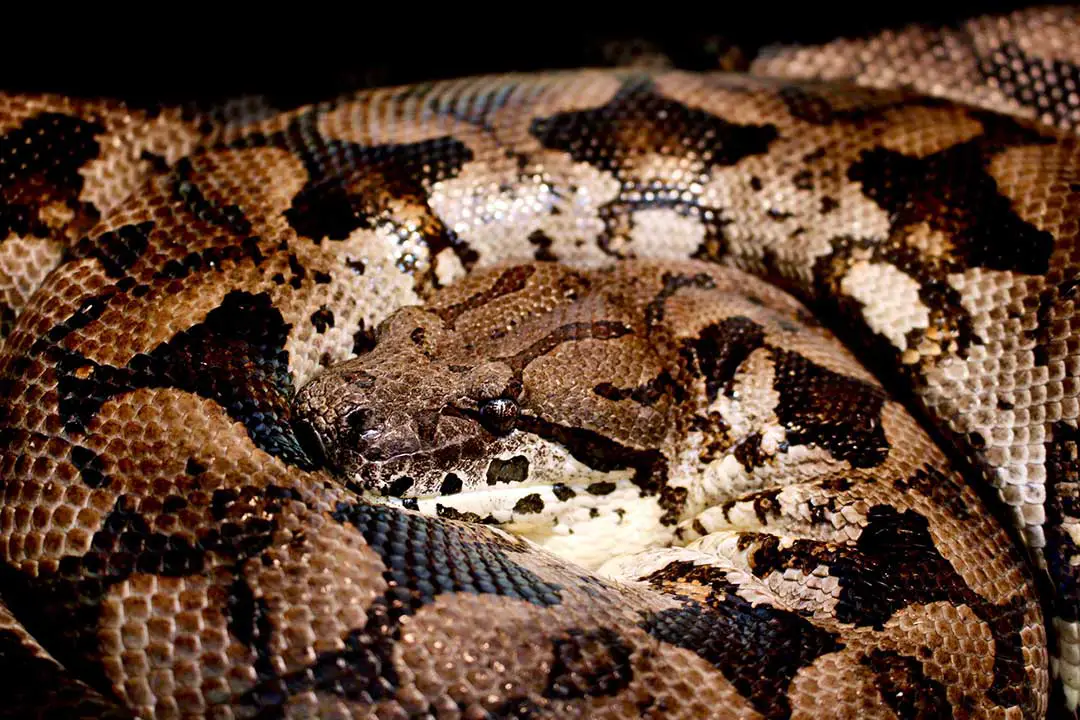Acrantophis dumerili (after this known as A. dumerili) or the dumeril’s boa, are medium-sized, thick-bodied non-venomous boas that are easily found within the pet trade.
Though no longer being imported from their native land of Madagascar, these snakes breed readily within the care of humans and make for an excellent next step in herp keeping for most mid-level keepers.
Let’s take a look at how best to take care of these beautiful boas.
Housing
Dumeril’s boas are easily housed within a typical home, with their required enclosure (even as adults) not so large as to take up more than a coffee table or a large aquarium area.
These snakes are typically not much larger than large adult corn snakes or rat snakes, though their bodies are thicker and their weight significantly more impressive.
Since these boas are nocturnal, placing your dumeril’s boa enclosure in an extra room or along a dark hallway is ideal.
Enclosure for Dumeril’s Boas
If intending to get more than one A. dumerili, please remember that you’re going to need more than one enclosure.
These snakes will absolutely eat each other if placed in the same enclosure, especially as neonates, and may end up dying because of it. This is a seriously solitary species and care must be taken when you are breeding them because of it.
A proper enclosure for this species is a “shoebox”-style rack bin or a 5 gallon aquarium for neonates.
Adults should have access to a 4 ft by 4 ft by 2 ft snake box or a very, very large aquarium of similar measurement.
Custom Reptile Habitats – PVC & Aluminum Enclosure – 72 L x 24 W x 24 H
- Sliding glass doors – Enjoy this big viewing area with crystal clear 1/4 inch Tempered glass that won’t scratch or discolor over time
- Stunning design with super strong Anodized Aluminum frame – Looks great in your home and will never rust or peel
- Real PVC panels – The preferred choice for reptile enclosures. Holds high humidity and will never break, rot or catch fire
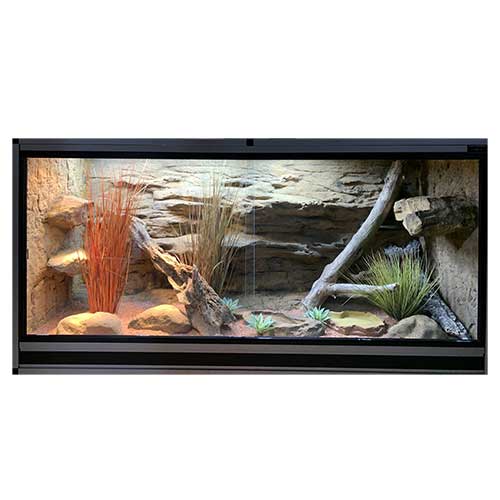
In all honesty, if you get a solid snake box for this species when they are sub-adult, you should never need to upgrade them again and the box will likely last the rest of the Dumeril’s boa’s lifespan.
Remember that these are not extremely high humidity snakes. A snake box should not swell or warp the way that it may with high humidity requirement species.
Front-opening Exoterras are plausible enclosures but will likely be too small for adults, especially adult females.
Still, we do prefer a front-opening enclosure for all species of snakes since predation usually comes from above and may put a nervous snake on edge.
Substrate Options
I really like aspen, coconut coir (eco earth snake substrate), or cypress for this species. While these snakes do not require the humidity of say, some of the Amazonian species, they do enjoy having a relatively moist place to settle into.
I’ve seen several of them bathing in their water bowls (and try to give them somewhere to do so at least once or twice a month, usually by adding a wide and shallow pan to their enclosure) and they seem to prefer a moisture gradient as much as they do a heat gradient.
A dry forest floor can be easily achieved when working with the above substrates, you simply mist one side a little more heavily than the other and the substrate eats it right up.
It’s also nice to work with these substrates since, in my experience, this tends to be somewhat of a more messy breed and it’s nice to be able to just scoop out wherever they’ve gone and have some absorption as opposed to using brown butcher paper and having the snake sling their mess absolutely everywhere.
Brown butcher paper or paper towels can be used for juvenile dumeril’s boas, but avoid cedar or pine shavings, they contain oils that can be harmful your snake’s skin and fumes that can lead to neurological issues when heated up.
Heating & Temperature Settings
Heating is easy with this breed. Since they are nocturnal, they require no extra lighting.
You can choose to give them a UV bulb, but it is unlikely that you will see any difference in health or comfort if you do decide to do this.
Enclosure temperature for Dumeril’s Boas
Hot end temperatures should not exceed 85 degrees, with temperatures not going below 75 on the cool side.
In all honesty, if you keep your reptile room at a steady 80-82 degrees, you may not even need to heat this enclosure; though most snakes do appreciate a heat gradient.
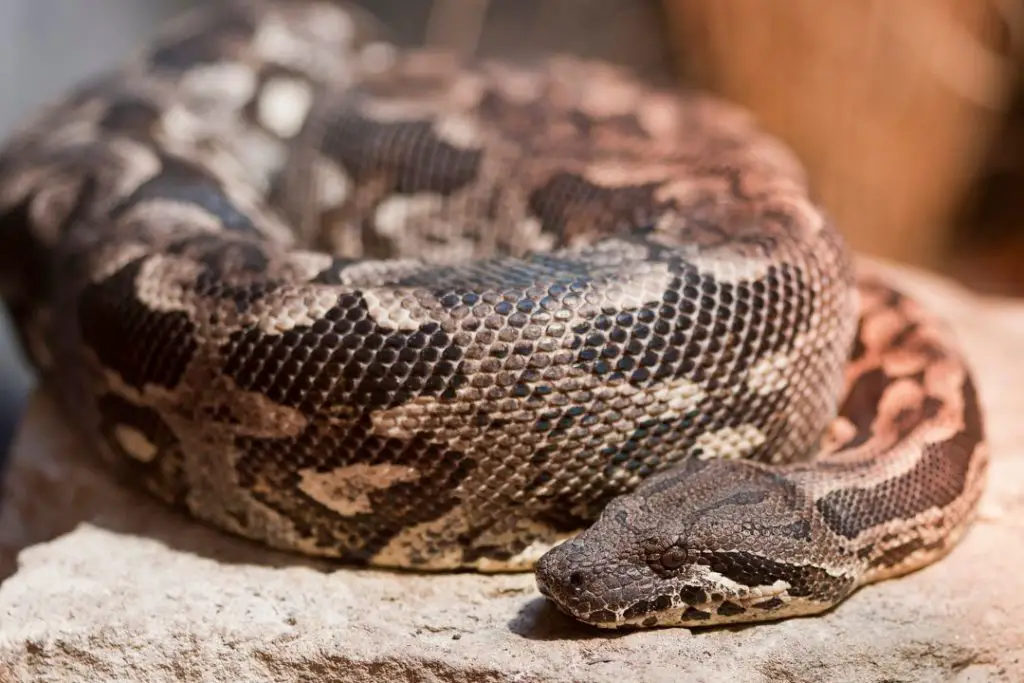
If your Dumeril’s boa is not living in a climate-controlled reptile room, we recommend using a heat mat against the hot side of the enclosure with a digital controller attached to it.
We also recommend using two probe thermometers on the ground level to make sure that your snake is being kept at proper temperatures so they can regulate their body temperature.
I recommend using a heating pad and thermometer controller, though the size of the heating pad depends on the size of your enclosure.
Please read the manufacturer’s suggestions based on the size of your enclosure to select the correct heating pad.
Use two thermometers (one on either end) to make sure that your temperature falls within the correct spectrum. Your snake should not get tangled in the wires.
Light
As mentioned earlier, this is a nocturnal species and therefore does not require extra lighting.
An aquarium hood with a simple LED light can be used to simulate the day/night cycle for the benefit of the snake, or you may decide to use UV lighting.
If you do use UV lighting, make certain that the enclosure does not overheat on the hot side since this species does not need a basking area.
Shelter & Decoration
Generally speaking, I don’t recommend living vivarium for this species due to their excellent ability to nose at plants (and even dig at them) until they fall over and die.
This has happened in every attempt at a vivarium I’ve worked at with Dumeril’s boas and I recommend a faux habitat over a living one for these guys.
Adults require pretty large hides of 20×20, with the really big females sometimes requiring an even larger hide.
In truth, we usually just use cardboard boxes (especially shipping boxes) after stripping the tape until they’re gross/obviously in need of replacement.
The Dumeril’s boas seem to love simplicity and that’s both kinder to your wallet as well as easier to replace.
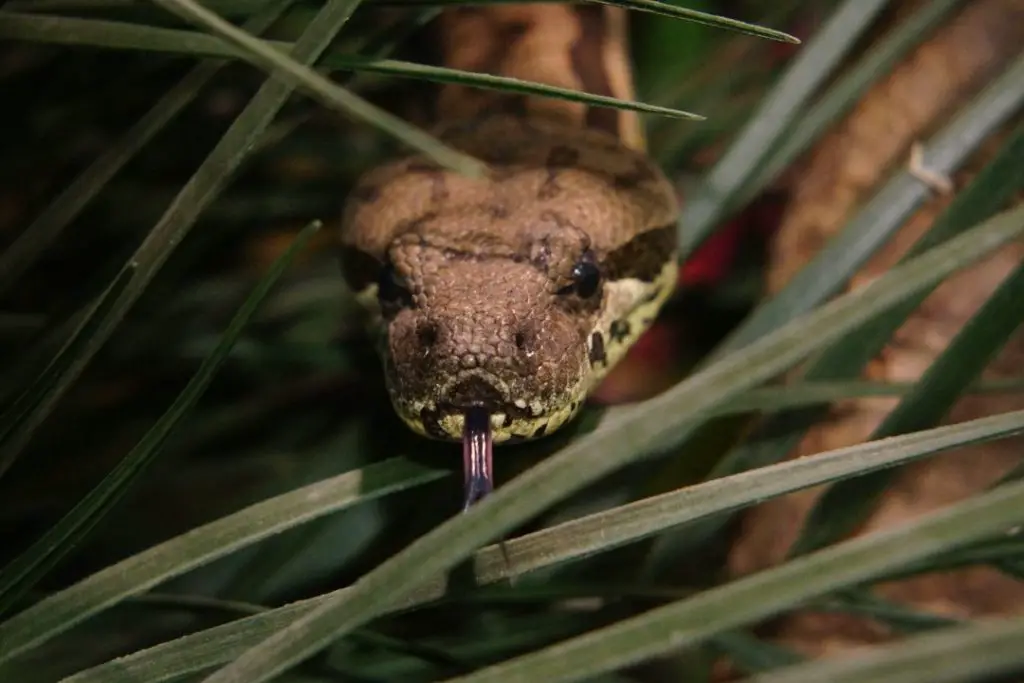
If you want something a little fancier, feel free to find some not-pine wood (cypress is great, ash is even better) and create a hide box for your bigger snakes.
For neonates to sub-adults, you can probably just find hides at your local pet store and grab what you want.
These snakes are technically ground-dwellers, but they have been seen in trees in the wild. Therefore, I do recommend a little bit of climbing fun for them.
Some people use bolted-on branches, and while I’ve used those, I like to sand down gritty bird perches a little bit and use those instead.
They can hold their weight and it gives them a great place to help catch shed and rub it off. If you have the space, use both and let the snake decide what they want to rope themselves all over.
Fake foliage is usually not well appreciated and just gets in their way, so I’d skip that and invest in nicer hides.
If desired, Dumeril’s boas appreciate a humid hide but they are absolutely not necessary in this species if you’re stuck with a little less room than you’d prefer, or if the snake simply does not seem to be using them.
Water
Let them swim! Give your Dumeril’s boa a place to fully submerge as well as allowing them a place to drink fresh water. The fresh water bowl should be relatively shallow so they don’t think that’s where their swimming hole is.
Change both bowls at least twice a week or whenever they release feces into it; which they will frequently do. Like I said; they can be messy snakes.
We do recommend that you grab a heavier set of water bowls if at all possible.
Great bathing areas are low, deep plastic storage boxes while the stoneware found at your local pet store or a weighted “tipless” dog water bowl are perfect for their drinking dish.
Humidity
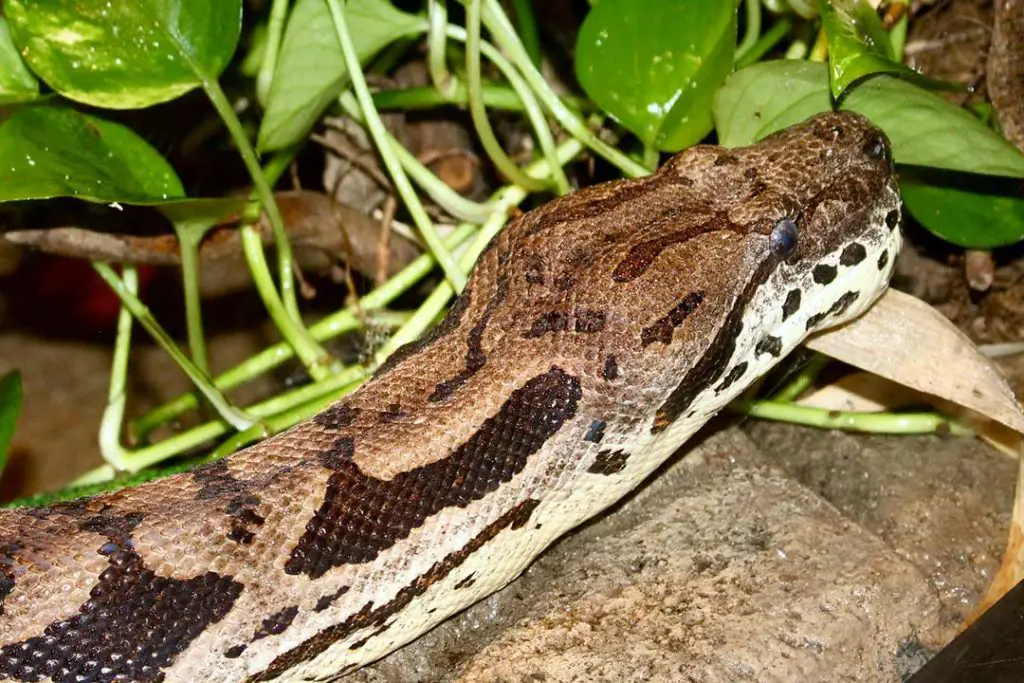
No matter how high or low the humidity your species prefers, always make sure to have a hygrometer on both sides of the enclosure (the hot and the “cold” side) to make sure that your humidity is the same throughout.
Though up above we recommended a digital thermometer without a hygrometer attached, they do make these and we do highly recommend them if you have the extra cash to spare.
Humdity Requirements for Dumeril’s Boas
Dumeril’s boas prefer a range of humidity from 40-60%. This is usually easily achieved in non-desert or steppes locations around the world simply by monitoring your own air quality.
Most homes are somewhere between 45-70% on average. However, do not simply assume that your home has the proper humidity for your new pet. Invest in good hygrometers to be certain.
If you do live in an area that is relatively arid, simply mist your Dumeril’s boa as necessary per the hygrometer rating.
The large bowls in the enclosure and cypress mulch in a hiding, or a layer of leaf litter on top of the substrate should also help with humidity retention.
Remember not to mist the snake directly, however, and mist the substrate instead.
Regular Maintenance
Watch for mold and mildew if you are using a plant-based substrate like the ones listed up above. Spot cleaning should be done within the enclosure if mold/mildew is spotted or if the snake soaks the substrate beyond reason or defecated.
Dumeril’s boas, again, do tend to be messy snakes when it comes to the far side of digestion and this may require you to get a cat litter scoop after a large chunk of the substrate.
Every other month you should dump the contents of the enclosure and start over with new substrate. Wipe down branches and so on and so forth.
Remember to remove sheds as soon as they occur and to look for loose wires or torn up decorations when you are cleaning.
Feeding
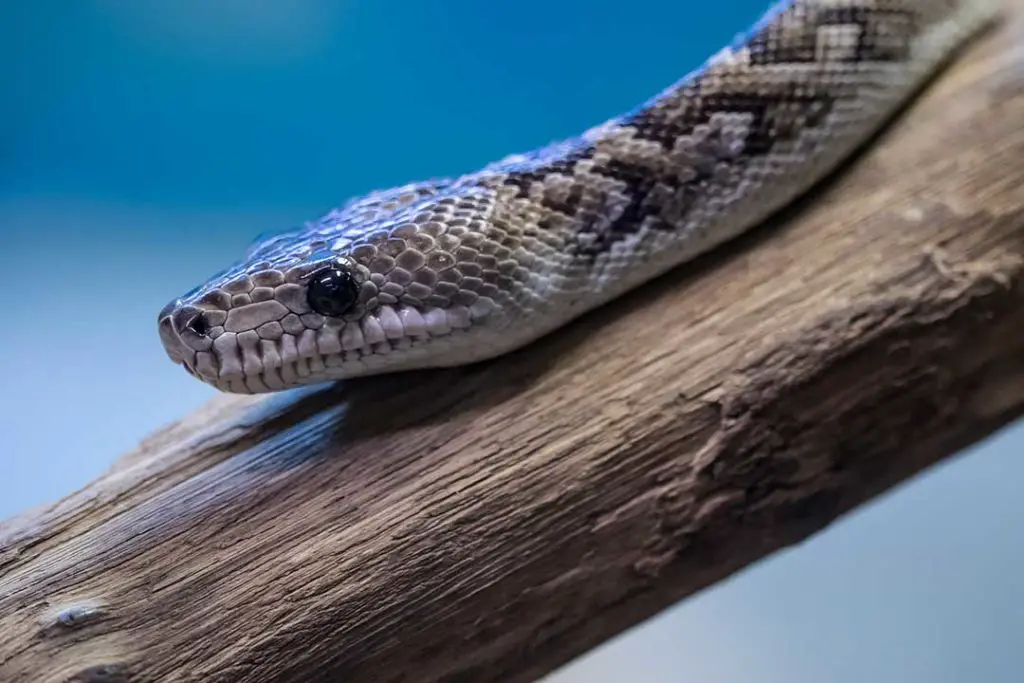
Dumeril’s boas are easy to feed and excited about dinner time. Though they may strike a human accidentally here and there, it is very rare that this occurs in this author’s experience.
Again, these are relatively sensible snakes and do seem to try to avoid strikes that will not result in a meal.
The old idea of making snakes survive on mice and rats alone is falling to the wayside. If you can, occasionally enrich your snake’s diet with a chick, a quail, or even a hamster (if available).
Type and Size of Prey
We’ll get into frozen vs live in a moment, but most Dumeril’s boa diets should consist primarily of small rodents with the occasional bird or lizard.
These may be more difficult to find than the average mouse or rat, which are easily and constantly produced by large animal feed houses; and may cost a bit more, too.
However, you can easily raise a litter of hamsters or hatch some quail even if you live in an apartment, then simply humanely euthanize the appropriately-sized animals for your snake and freeze them yourself.
Ideally, as with any species, your prey item is never larger around than the thickest part of the snake. However, we usually recommend it be up to 1/3rd smaller simply so the snake is not stressed with a large prey item.
As it is, Dumeril’s boas never get so large that you’ll be required to feed rabbits or anything like that.
The biggest of females probably won’t be able to eat anything larger than a guinea pig (and even then, a small guinea pig) at full adult weight and width. Most will be able to stick to large rats at adulthood if that is all that you can get.
Frozen or live?

For all snake species we recommend frozen/thawed pre-killed prey for the safety of the snake and the humane preference to the prey animal.
You can easily purchase a base diet of mice and rats in a variety of sizes appropriate from neonate (pinky) mice to full-sized rats.
While most snakes have an excellent feeding response, if your Dumeril’s boa will not take a frozen/thawed prey animal, you may have to start them with live prey. Before you do this we suggest training and scenting the mouse (or rat pup) with another species.
Honestly? I keep a very tolerant parakeet that lets me do this with his cage and it’s rarely not worked for me. You can also try warming the pre-killed prey animal in a little lukewarm water just in case the death chill is the snake’s issue.
If you’ve exhausted all of the options and the snake still isn’t eating, try stunning a live prey animal and offering it on tongs skittering around the cage.
We do not recommend releasing a live, awake prey animal into a Dumeril’s boa’s cage simply because they are a relatively calm snake and tend to get bitten by their own food. This can then turn them off of food entirely or even make them fearful of it.
Feeding frequency
Juveniles smaller than 4′ long should be fed weekly. The feeding schedule is approximately bi-weekly after that. Keep a watch on your animal’s weight.
If your Dumeril’s boa begins to drop weight, feed more often. If the snake becomes obese, feed less often.
Shedding
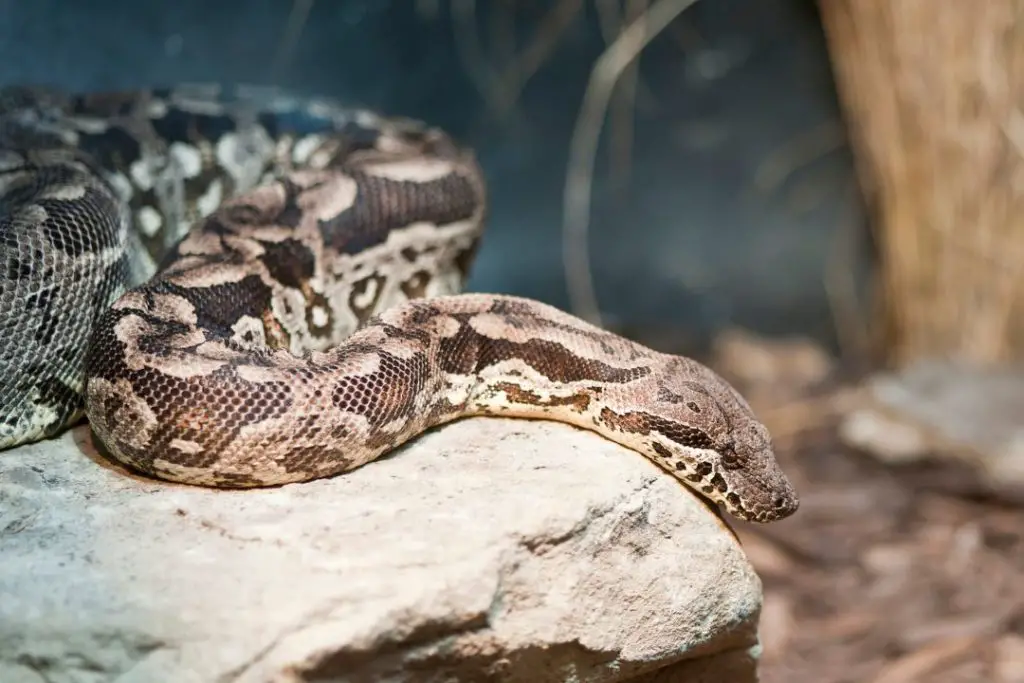
Since a Dumeril’s boa is such a humidity-relaxed snake, it is unlikely that this species will have shedding problems based around humidity issues.
However, they may have problems due to not having enough rough spots in their enclosure to break the skin over their snout or along the snake’s body.
This is why I recommend the bird perches that I talk about earlier in this article. These seem to be a little thicker skinned than some other locality-based species and giving them a little extra help is a great idea.
For newer keepers, shedding is what happens when a snake outgrows their old skin. They peel off the old layer and leave it laying in their enclosure.
You’ll notice that your snake’s eyes get milky-colored before the snake sheds. This is called being “in blue” and the snake will likely be more aggressive and defensive during this time. Handle with care.
In no time, they’ll look ‘brand new’ with their beautiful pattern ( their mottled brown color form an effective camouflage against the leaf litter in their natural habitat).
Hibernation
Dumeril’s boas are unlikely to hibernate in the care of humans unless the setup is very, very correct to the temperatures, light cycle, and so forth found in Madagascar.
If you simply allow the snake to be its normal self throughout the year and keep temperatures, light cycles, and so forth in line with that, your snake is going to remain active.
If you do desire to hibernate your Dumeril’s boa, their natural hibernation period is May to July or August, since these are the coldest and darkest times in their wild habitat.
It is up to you if you desire to do this, though most Dumeril’s boas will come out of hibernation incredibly hungry and ready to zoom around their enclosure.
Handling
This is an easy species to handle and train to the snake hook very well, if you desire to work with them in that way.
Avoid handling a Dumeril’s Boa alone
Large adults will likely require 2-3 adult human beings to handle for safety’s sake despite their docile nature.
Keep in mind that the biggest female Dumeril’s boas can do harm to wrapped human appendage without meaning to and it is a great idea to have someone else there to help you unravel them in case of emergency.
In addition to this, you may simply need more hands than your own to help you transport the bigger adults thanks to their body weight (up to 20 lbs).
Regardless. Dumeril’s boas are absolutely willing to be handled and happy for out of enclosure time with their family, they make a great pet snake.
Breeding
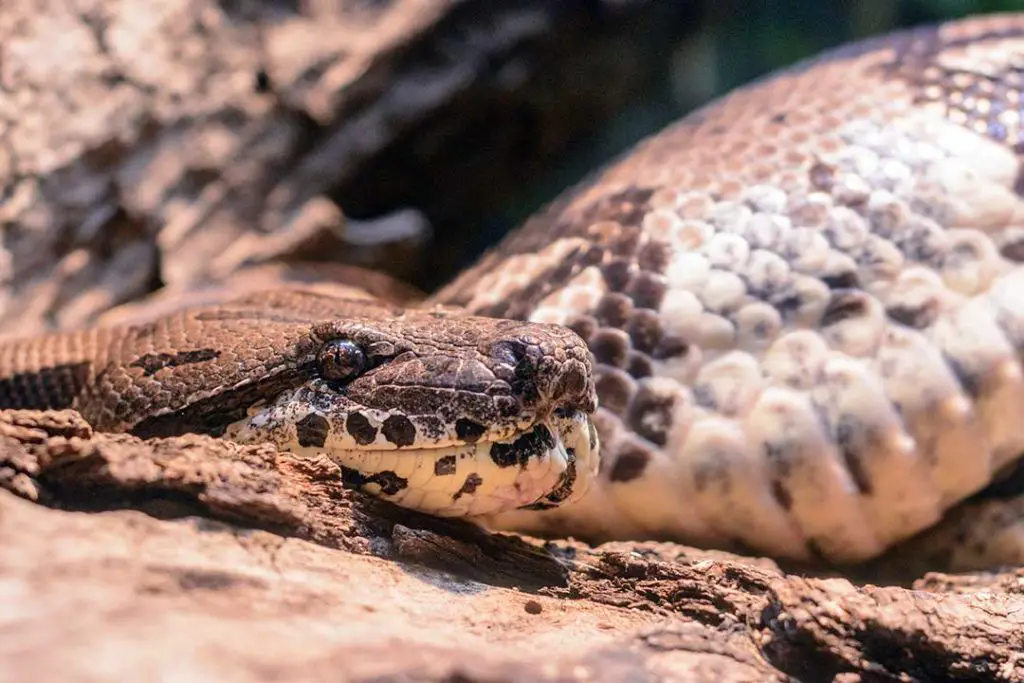
The Dumeril’s boa breeds readily in the care of humans, which makes it a favorite among mid-level keepers and those who want something a little more challenging than your average ball python or corn snake.
This is fantastic livebearing species (technically ovoviviparous) that gives birth to snakelets that are ready to go the moment they are born.
The young are surprisingly large, given the size of the female, and should be removed from her enclosure when they begin to venture forth.
This is the only time in their young lives that they may be housed together, and only briefly: most keepers feed their litter their first meal together than separate them off into their own enclosures for meal two and to make certain that all their plumbing is functioning.
Common problems
A Dumeril’s Boa is Not eating
This is not a finicky eater. The Dumeril’s boa is probably one of the best eaters in this range of snakes available for the commercial market throughout the world.
Bluntly, if your snake is not eating and it is not grossly obese, there is probably something wrong and you should speak to your snake vet about it as soon as possible.
However, if it is only one meal and something has changed within the enclosure (or the enclosure is not getting as much light as it once was) there is a good chance that the snake may be readying to hibernate.
Try turning on a light nearby or over the enclosure to help get the snake back into eating mode.
A Dumeril’s Boa is Not Moving
If your snake is still alive (and we certainly hope that it is), make sure that your temperatures aren’t too cold on either side of the enclosure.
Place your probe in the area where the snake is laying or use a heat-checking gun to see what the temperature is next to the snake. Chances are that your heat mat has gone out or your thermostat is having problems.
Hiding in the Water Constantly
If your snake is constantly in the water, there could be a few things wrong. The first that I consider is that the snake has an infection and a fever and is trying to cool itself off.
The next is that your snake is feeling very dehydrated. If your hygrometer is showing very low humidity levels, mist your enclosure and see if your Dumeril’s boa comes out to see what’s going on.
Last, if your snake just will not come out of the water, it could be constipated.
Though this is a rare issue in Dumeril’s boas, it does happen when you change food for a higher bone percentage (say, a rat for a quail) and it may take a little time for the snake to get things moving again. The best way for them to do this? Soaking in a cool pool of water.
Frequently Asked Questions
Sources
- Somma, L.A., Krysko, K.L. and Conner, L.L., 2017. Geographic distribution: Acrantophis dumerili (Duméril’s Madagascan Ground Boa). USA. Florida.
- Gardner, C.J., McDonnell, N., Ellis, C. and Jasper, L.D., 2017. Observations of aquatic behaviour in Malagasy ground boas Acrantophis madagascariensis (Duméril & Bibron, 1844) and A. dumerili Jan, 1860. Herpetology Notes, 10, pp.271-273.
- Dumeril’s Boa – Seneca Park Zoo
In Closing
The Dumeril’s boa (scientific name: Acrantophis dumerili) is an extremely easy to work with intermediate snake for the average at-home keeper to adopt and learn about.
These snakes are able to take a mistake or two without getting sick, though we recommend that you try to avoid having mistake happen at all with living creatures.
Much like corn snakes, ball pythons, rat snakes, and all the beginner species that people suggest, the Dumeril’s boa is a fantastic pet and a great education animal to take into schools to show the world just how wonderful snakes are. Happy Herping!
